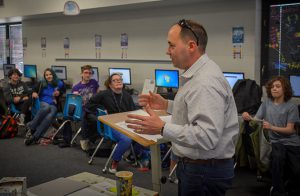It was a sunny Friday afternoon. Students rushed out of Alice Drive Middle School in Sumter, SC, ready to start their weekend. 15 students stayed behind. Laughter filled the classroom as they were getting ready for their club meeting. Their club is officially called the Science Fiction and Fantasy Federation, short SF3. Their weekly two-hour club meetings are providing them with a creative outlet for their diverse interests in the areas of science fiction, fantasy, and fandom genres. This may all sound like fun and games, which is certainly part of the club activities, but club members don’t simply chat for two hours about the latest sci-fi flick or memes. With the guidance and support of club advisors Joe Bettinger and Jennifer Spann, club activities challenge them to broaden their communication skills, use technology, and become involved with their community. Students can undertake research activities for projects, such as game design, to support technology and mathematics. STEM plays a role in SF3 activities, which is not surprising, as Alice Drive Middle School is a 21st century nationally accredited STEM school.

On this Friday, February 1, 2019, the SF3 Club welcomed two Cosmographers Katrin and Rick Galeano. The two University of Arkansas at Little Rock Information Science Ph.D. fellows spoke about board games. They led an interactive discussion with students about the concept of games, types of games and characteristics of games. “Incorporating design at an early age into programs like this encourages students to reach beyond their potential and develop thought processes critical to higher education,” said Rick.
After Jennifer Spann, club co-advisor and mentor, introduced the guests, Rick started off by asking, “Who wants to learn about game theory?”, insinuating that he would focus on mathematical models. Instead, he used real-life examples to show how frequently game theory is used.
“Think of STEM programs as an interdisciplinary approach to learning, students that develop games are developing concepts to think through problem sets that they will encounter throughout life,” noted Katrin, “This club doesn’t only offer students with common interests to get together, but it challenges them. The students impressed me today with their insights and creativity.”
The second part of the club meeting focused on student feedback and collaboration. Katrin asked them about their favorite board games. Students enthusiastically named games, followed by a brief description and reason why it was their top pick, which included Battle Sheep, Labyrinth, Tsuro Of The Seas, and Munchkin. It was not only the teenagers who learned something new. Their guests quickly became schooled up on a variety of games.
Thinking about their favorite game, why they liked it and how it is played made students think about game mechanics, an important aspect of every game, including the one the students were about to start designing.
“Our students have spent the year playing a variety of games to get an idea of how some game mechanics work together with synergy,” said Jennifer Spann, “Encouraging them to build games allows them the opportunity to incorporate their own themes with the game mechanics they like best.”
In groups of three, students began brainstorming about the game they will be creating throughout the next weeks. Katrin gave them a number of aspects to consider: game objective, game pieces, set-up, and instructions, which they began typing up on their computers. Next week, they will begin with game construction. They will present their games to the group and gather peer feedback for further improvements. Students will then vote for the top two games that will then be created using STEM resources at the school. We will keep you updated about their progress.
